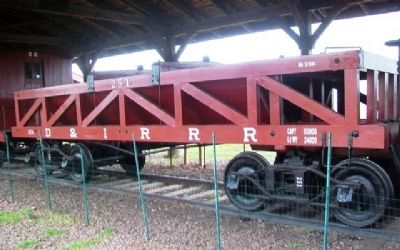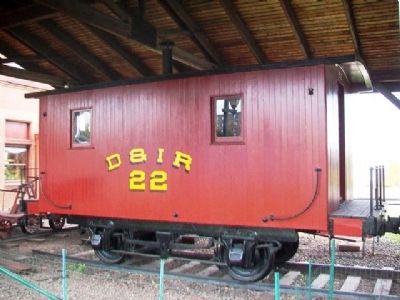Two Harbors in Lake County, Minnesota — The American Midwest (Upper Plains)
Ore Car #251, 1884 & Bobber Caboose #22 (#52), 1893
Inscription.
The first D&IR wooden ore cars were purchased from the Northwestern Manufacturing Co. in 1884. The first order was for 300 cars at a cost of $615 each. The cars had a capacity of 20 tons but were often overloaded. The lifespan of this equipment was relatively short as the Vermillion ore was extremely heavy, hard and abrasive. The rolling stock required constant maintenance and provided a lot of work for the car shop. The first ore cars were 28 feet long and did not line up with the pockets on the newly constructed docks. The car shop would eventually convert these cars into 24 foot cars that lined up better with the pockets on the docks.
Due to the opening of many mines, and the influence of the Porter Group after acquiring the Minnesota Iron Company in 1886, the railroad expanded at an enormous rate. The years between 1892 and 1899 saw the railroad purchase over 2,035 wooden ore cars at an average price of $429 each. The hard Vermilion ore continued to exact its toll on wooden equipment and by 1899 the railroad had ordered new steel ore cars.
From 1900 on only steel ore cars were purchased and the last wooden ore cars saw service on the D&IRR in 1909. Many were sold to the Duluth & Northern Minnesota (Alger Smith). By 1919 the D&IRR had purchased 5,705 new steel ore cars.
D&IRR Caboose #52 was purchased in 1893 from the Duluth Manufacturing Company. It has the distinction of being the only caboose to begin life as a four wheel bobber caboose that was extended to an eight wheel caboose in 1909 and then returned to the original four wheel configuration for this display. This caboose stayed in service until about 1932 when it was retired. The caboose now displays the number 22 representing the first number in this series of cabooses.
In 1934 as part of the 50 Years of Ore Celebration the ore car and caboose were added to the 3 Spot Display. The original 28 foot ore car #251 arrived in Agate Bay by barge in 1884 and was in service until 1896. The original number of the ore car on display can best be narrowed down to 290, 316, or 340. It was transformed into gravel and ballast spreader #2 in 1899. It remained in service until the Great Depression forced the railroad to reduce itís inventory. It was sold for scrap and after some negotiations with the scrap yard was reclaimed by the D&IRR Veterans Association and restored by the car shop here in Two Harbors. It bears the number of the D&IRís first ore car, #251.
Some notes in general about the display. Two of the things not found on this equipment are air brakes and automatic couplers. Air brakes did not come into use until 1889 and automatic couplers were not installed on all the equipment until 1895.
It is amazing that more people were not hurt while these cars were in service. The image of traveling down the mainline at 35 miles per hour and having a brakeman jumping from car to car to apply the hand brakes is simply unbelievable. Imagine being between these cars holding the link and pin coupler in place as trains were being assembled.
These interpretive panels and restoration work was made possible by the LaBounty Family Fund, part of the Duluth Superior Area Community Foundation.
[Image captions, from top to bottom, read]
Ore punchers working on the docks
24 foot wooden ore car manufactured by the LaFayette Car Co.
Diagram of Double Gravel Spreader #1 as it appeared in 1910.
Caboose being set on display in 1934.
Photos courtesy of Missabe Railroad Historical Society [and] Lake County Historical Society
Erected by Lake County Historical Society.
Topics. This historical marker is listed in these topic lists: Industry & Commerce • Railroads & Streetcars. A significant historical year for this entry is 1884.
Location. 47° 1.128′ N, 91° 40.234′ W. Marker is in Two Harbors, Minnesota, in Lake County. Marker and equipment are at the Lake County Historical Society Depot Museum. Touch for map. Marker is at or near this postal address: 520 South Avenue, Two Harbors MN 55616, United States of America. Touch for directions.
Other nearby markers. At least 8 other markers are within walking distance of this marker. First Ore Taken From A Minnesota Mine (here, next to this marker); a different marker also named First Ore Taken From A Minnesota Mine (here, next to this marker); Duluth and Iron Range Railroad Locomotive #3 (a few steps from this marker); The Two Harbors Ore Docks (a few steps from this marker); Hand Car, Velocipede, Sleigh, Station Wagon (a few steps from this marker); Duluth and Iron Range Depot (a few steps from this marker); Duluth Missabe & Iron Range Yellowstone Mallet #229 (within shouting distance of this marker); Welcome to Paul H. Van Hoven Park (about 600 feet away, measured in a direct line). Touch for a list and map of all markers in Two Harbors.
Also see . . .
1. Lake County Historical Society Depot Museum. Museum website homepage (Submitted on November 11, 2014, by William Fischer, Jr. of Scranton, Pennsylvania.)
2. Missabe Railroad Historical Society. Society website homepage (Submitted on November 11, 2014, by William Fischer, Jr. of Scranton, Pennsylvania.)
3. The Duluth, Missabe and Iron Range Railway. American Rail website entry (Submitted on November 11, 2014, by William Fischer, Jr. of Scranton, Pennsylvania.)
Credits. This page was last revised on December 3, 2022. It was originally submitted on November 11, 2014, by William Fischer, Jr. of Scranton, Pennsylvania. This page has been viewed 503 times since then and 20 times this year. Photos: 1, 2, 3. submitted on November 11, 2014, by William Fischer, Jr. of Scranton, Pennsylvania.


